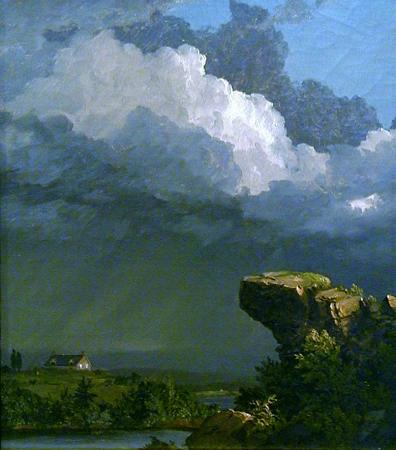Landscape with Storm. A storm is any disturbed state of a body especially affecting its surface, and strongly implying a wind force. It may be marked by significant disruptions and lightning, heavy precipitation, heavy freezing rain, strong winds, or wind transporting some substance through the atmosphere as in a dust storm, blizzard, sandstorm, etc. Storms have the potential to harm lives and property via storm surge, heavy rain or snow causing flooding or road impassibility, lightning, wildfires, and vertical wind shear. Systems with significant rainfall and duration help alleviate drought in places they move through. Heavy snowfall can allow special recreational activities to take place which would not be possible otherwise, such as skiing and snowmobiling. The English word comes from Proto-Germanic sturmaz meaning noise, tumult. Storms are created when a center of low pressure develops with the system of high pressure surrounding it. This combination of opposing forces can create winds and result in the formation of storm clouds such as cumulonimbus. Small localized areas of low pressure can form from hot air rising off hot ground, resulting in smaller disturbances such as dust devils and whirlwinds There are many varieties and names for storms: Blizzard There are varying definitions for blizzards, both over time and by location. In general, a blizzard is accompanied by gale-force winds, heavy snow, and very cold conditions. Lately, the temperature criterion has fallen out of the definition across the United States. Bomb cyclone; A rapid deepening of a mid-latitude cyclonic low-pressure area, typically occurring over the ocean, but can occur over land. The winds experienced during these storms can be as powerful as that of a typhoon or hurricane. Coastal Storm; Large wind waves and/or storm surge that strike the coastal zone. Their impacts include coastal erosion and coastal flooding. Derecho; A derecho is a widespread, long-lived, straight-line wind storm that is associated with a land-based, fast-moving group of severe thunderstorms. Dust devil; A small, localized updraft of rising air. Dust storm; A situation in which winds pick up large quantities of sand or soil, greatly reducing the visibility. Firestorm; Firestorms are conflagrations which attain such intensity that they create and sustain their own wind systems. It is most commonly a natural phenomenon, created during some of the largest bushfires, forest fires, and wildfires. The Peshtigo Fire is one example of a firestorm. Firestorms can also be deliberate effects of targeted explosives such as occurred as a result of the aerial bombings of Dresden. Nuclear detonations generate firestorms if high winds are not present. Gale; An extratropical storm with sustained winds between 34-48 knots. Hailstorm; A type of storm that precipitates round chunks of ice. Hailstorms usually occur during regular thunderstorms. While most of the hail that precipitates from the clouds is fairly small and virtually harmless, there are occasional occurrences of hail greater than 2 inches in diameter that can cause much damage and injuries. Hypercane; A hypothetical tropical cyclone that could potentially form over 50 °C water. Such a storm would produce winds of over 800 km/h. A series of hypercanes may have formed during the asteroid or comet impact that killed the non-avian dinosaurs 66 million years ago.
more...














